【C++】priority_queue&&priority_queue模拟实现
【C++】priority_queue&&priority_queue模拟实现

文章目录
- 1. priority_queue的介绍
- 2. priority_queue的使用
- 3. 函数模板与类模板
- 4. 仿函数
- 5. priority_queue模拟实现
- 5.1 push
- 5.2 pop
- 5.3 empty
- 5.4 size
- 5.5 top
- 5.6 仿函数实现大小堆
- 5.7 实现自定义类型的优先级队列
- 6. 附模拟实现代码
1. priority_queue的介绍

- 优先队列是一种容器适配器,根据严格的弱排序标准,它的第一个元素总是它所包含的元素中最大的。
- 此上下文类似于堆,在堆中可以随时插入元素,并且只能检索最大堆元素(优先队列中位于顶部的元素)。
- 优先队列被实现为容器适配器,容器适配器即将特定容器类封装作为其底层容器类,queue提供一组特定的成员函数来访问其元素。元素从特定容器的“尾部”弹出,其称为优先队列的顶部。
- 底层容器可以是任何标准容器类模板,也可以是其他特定设计的容器类。容器应该可以通过随机访问迭 代器访问,并支持以下操作: empty():检测容器是否为空 size():返回容器中有效元素个数 front():返回容器中第一个元素的引用 push_back():在容器尾部插入元素 pop_back():删除容器尾部元素
- 标准容器类vector和deque满足这些需求。默认情况下,如果没有为特定的priority_queue类实例化指定容器类,则使用vector。
- 需要支持随机访问迭代器,以便始终在内部保持堆结构。容器适配器通过在需要时自动调用算法函数make_heap、push_heap和pop_heap来自动完成此操作。
2. priority_queue的使用
优先级队列默认使用vector作为其底层存储数据的容器,在vector上又使用了堆算法将vector中元素构造成堆的结构,因此priority_queue就是堆,所有需要用到堆的位置,都可以考虑使用priority_queue。注意:默认情况下priority_queue是大堆。

来代码测试看看大堆:
void test_priority_queue()
{
priority_queue<int> pq;
pq.push(2);
pq.push(1);
pq.push(4);
pq.push(3);
while (!pq.empty())
{
cout << pq.top() << " ";
pq.pop();
}
cout << endl;
}
int main()
{
test_priority_queue();
return 0;
}默认情况下,priority_queue是大堆
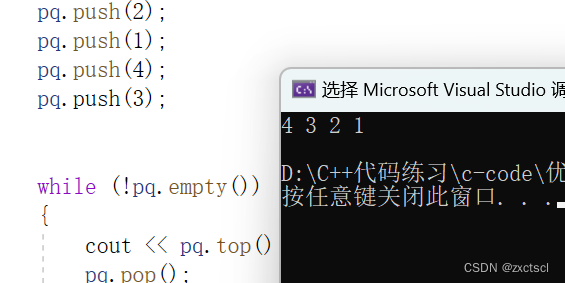

priority_queue默认情况下是less大堆,

想要priority_queue默认改为小堆,就得传三个参数。
用代码来测试一下:
#include<iostream>
using namespace std;
#include<vector>
#include<queue>
void test_priority_queue()
{
priority_queue<int,vector<int>,greater<int>> pq;
pq.push(2);
pq.push(1);
pq.push(4);
pq.push(3);
while (!pq.empty())
{
cout << pq.top() << " ";
pq.pop();
}
cout << endl;
}
int main()
{
test_priority_queue();
return 0;
}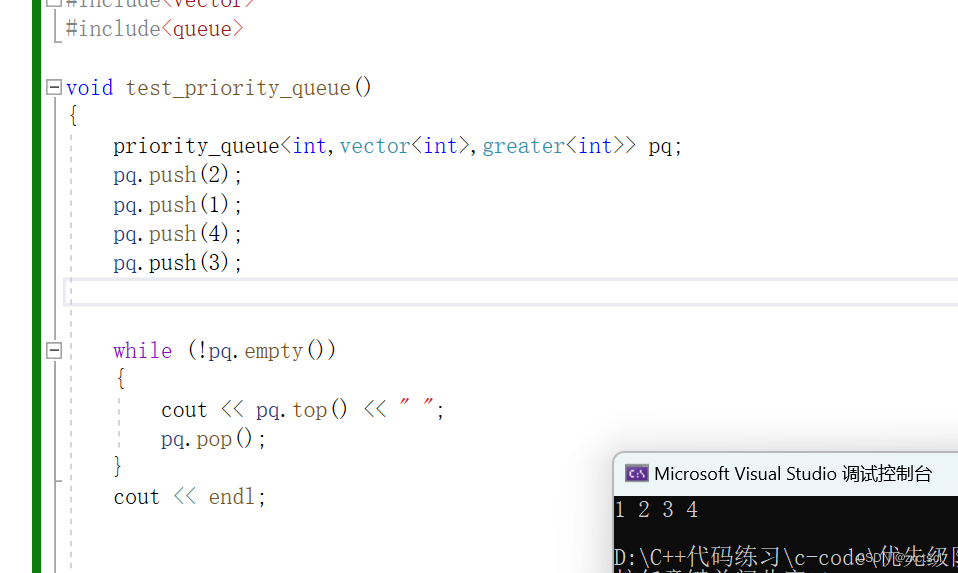
3. 函数模板与类模板
sort默认排序也是升序

vector<int> v = { 3,1,7,4,6,3 };
// 升序
sort(v.begin(), v.end());
for (auto e : v)
{
cout << e << " ";
}
cout << endl;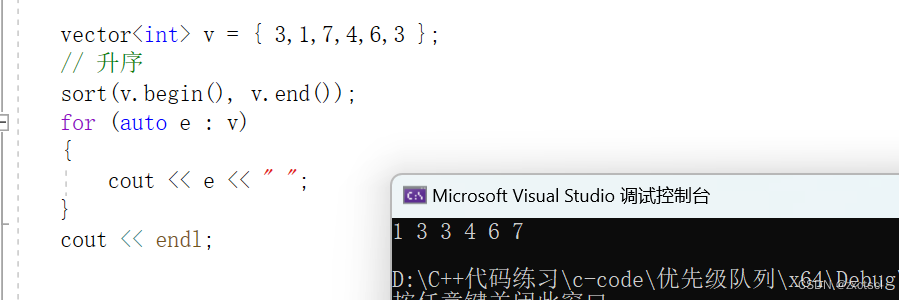
想要将sort排序默认改为降序,就得加仿函数:
vector<int> v = { 3,1,7,4,6,3 };
sort(v.begin(), v.end(), greater<int>());
for (auto e : v)
{
cout << e << " ";
}
cout << endl;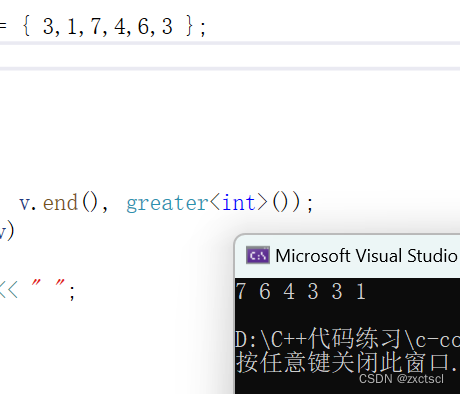
sort这里是函数模板,函数参数传的是对象。

而priority_queue传的是类型,需要显示实例化
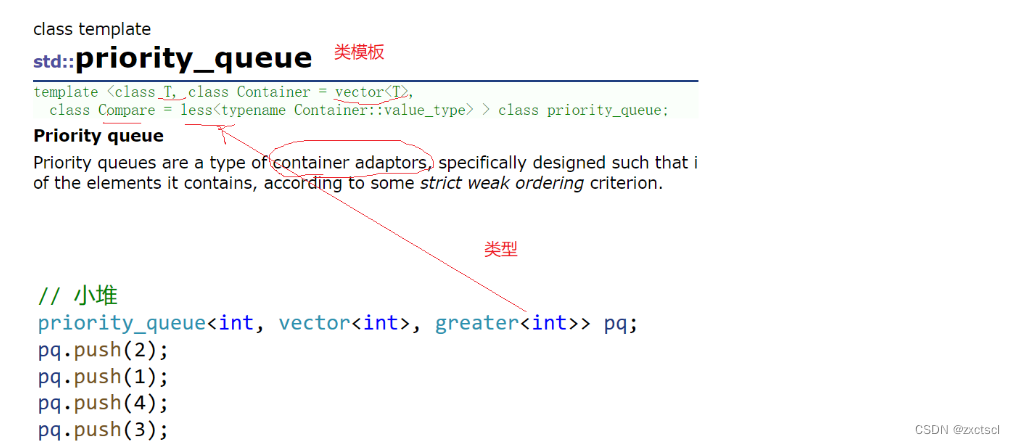
4. 仿函数
仿函数就是一个函数对象,就是一个类型。 先来实现一个类:
struct Less
{
bool operator()(const int& x, const int& y)
{
return x < y;
}
};
int main()
{
Less lessfunc;
cout << lessfunc(1, 2) << endl;
cout << lessfunc.operator()(1, 2) << endl;
cout << Less()(1, 2) << endl;
return 0;
}如果单独看红色框这一行,就会以为lessfunc是一个函数名,但它并不是,它是一个像函数的对象。

仿函数它的对象可以像函数一样去使用,本质上就是调用operator(): 这两个是等价的:

还有能用匿名对象:

它本质上就是:


这里重载函数调用参数的(),其实就像[]一样,v[0]也就是v.operator:

本质上就是参数留下,变成运算符的操作数。 运算符重载中operator加运算符才是函数名,省略掉的就是.operator加括号。 一个类只要重载了operator()就可以调仿函数。

加模板就直接可以重载为泛型,什么类型就可以支持。
template<class T>
struct Less
{
bool operator()(const T& x, const T& y)
{
return x < y;
}
};
int main()
{
Less<int> lessfunc;
cout << lessfunc(1, 2) << endl;
cout << lessfunc.operator()(1, 2) << endl;
cout << Less<int>()(1, 2) << endl;
cout << Less<int>().operator()(1, 2) << endl;
return 0;
}这里定义类用struct和class有什么区别? 一般所有数据都公有就用struct, 有些公有,有些私有就用class。
5. priority_queue模拟实现
直接复用容器
5.1 push

插入一个数据后,向上调整,具体实现过程有需要可以看【数据结构】堆的实现
push代码:
void adjust_up(size_t child)
{
size_t parent = (child - 1) / 2;
while (child>0)
{
if (_con[child] > _con[parent])
{
std::swap(_con[child], _con[parent]);
child = parent;
parent = (child - 1) / 2;
}
else
{
break;
}
}
}
void push(const T& x)
{
_con.push_back(x);
adjust_up(_con.size() - 1);
}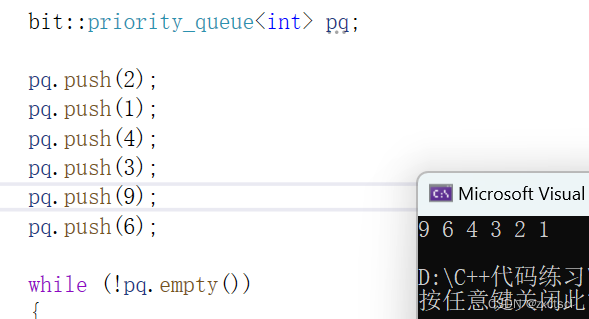
5.2 pop

就这样删除效率太低了,通常首位交换一下。向下调整,具体实现过程有需要可以看【数据结构】堆的实现
pop代码实现:
void adjust_down(size_t parent)
{
size_t child = parent * 2 + 1;
while (child< _con.size())
{
if (child + 1<_con.size() && _con[child + 1]>_con[child])
{
++child;
}
if (_con[child] > _con[parent])
{
std::swap(_con[child], _con[parent]);
parent=child ;
child = parent * 2 + 1;
}
else
{
break;
}
}
}
void pop()
{
swap(_con[0], _con[_con.size() - 1]);
_con.pop_back();
adjust_down(0);
}5.3 empty
bool empty()
{
return _con.empty();
}5.4 size
size_t size()
{
return _con.size();
}5.5 top
const T& top()
{
return _con.back[0];
}5.6 仿函数实现大小堆
想要大堆改小堆可以直接在代码上面修改,但是要实现大堆,代码又得重新修改。 这里就得用到上面提到的仿函数了。 写两个仿函数,一个实现大堆,一个实现小堆。
大堆实现:
template<class T>
struct less
{
bool operator()(const T& x, const T& y)
{
return x < y;
}
};
小堆实现:
template<class T>
struct greater
{
bool operator()(const T& x, const T& y)
{
return x > y;
}
};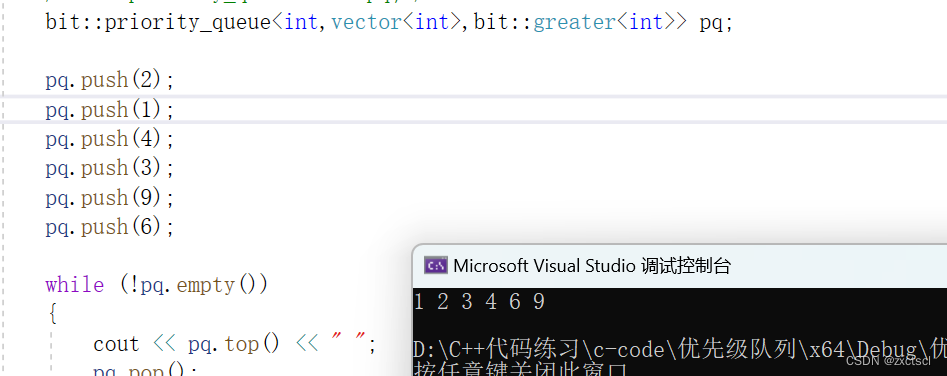
在写类模板的时候就把仿函数也一起传过去
template<class T, class Container = vector<T>, class Compare = less<T>>5.7 实现自定义类型的优先级队列
定义一个日期类:
class Date
{
public:
friend ostream& operator<<(ostream& _cout, const Date& d);
Date(int year = 1900, int month = 1, int day = 1)
: _year(year)
, _month(month)
, _day(day)
{}
bool operator<(const Date& d)const
{
return (_year < d._year) ||
(_year == d._year && _month < d._month) ||
(_year == d._year && _month == d._month && _day < d._day);
}
bool operator>(const Date& d)const
{
return (_year > d._year) ||
(_year == d._year && _month > d._month) ||
(_year == d._year && _month == d._month && _day > d._day);
}
private:
int _year;
int _month;
int _day;
};
ostream& operator<<(ostream& _cout, const Date& d)
{
_cout << d._year << "-" << d._month << "-" << d._day;
return _cout;
}用priority_queue来实现日期排序:


但是如果给的是指针:
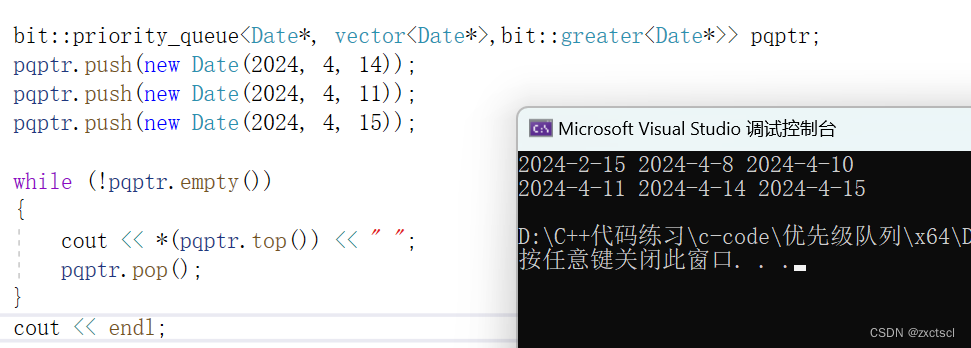

传地址每次给的结果不一样。 new不能保证每次new的地址都比前面的大,这里就得重新写一个仿函数。
class GreaterPDate
{
public:
bool operator()(const Date* p1, const Date* p2)
{
return *p1 > *p2;
}
};这个时候传地址就不会在变了:
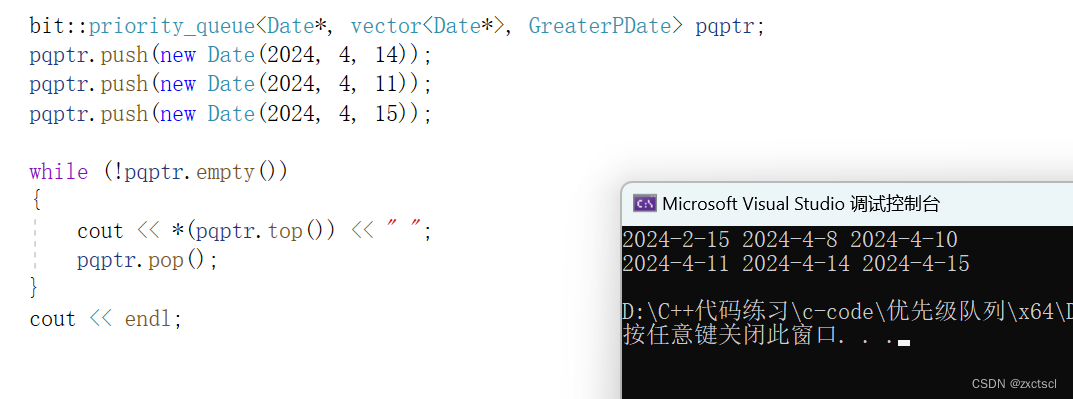
所以说仿函数控制比较逻辑,可以控制用什么去比较。
6. 附模拟实现代码
#pragma once
#include<vector>
namespace bit
{
template<class T>
class less
{
public:
bool operator()(const T& x, const T& y)
{
return x < y;
}
};
template<class T>
class greater
{
public:
bool operator()(const T& x, const T& y)
{
return x > y;
}
};
template<class T, class Container = vector<T>, class Compare = less<T>>
class priority_queue
{
public:
void adjust_up(size_t child)
{
Compare com;
size_t parent = (child - 1) / 2;
while (child > 0)
{
//if (_con[child] > _con[parent])
//if (_con[parent] < _con[child])
if (com(_con[parent], _con[child]))
{
std::swap(_con[child], _con[parent]);
child = parent;
parent = (child - 1) / 2;
}
else
{
break;
}
}
}
void push(const T& x)
{
_con.push_back(x);
adjust_up(_con.size() - 1);
}
void adjust_down(size_t parent)
{
Compare com;
size_t child = parent * 2 + 1;
while (child < _con.size())
{
//if (child + 1 < _con.size() && _con[child + 1] > _con[child])
//if (child + 1 < _con.size() && _con[child] < _con[child + 1])
if (child + 1 < _con.size() && com(_con[child], _con[child + 1]))
{
++child;
}
//if (_con[child] > _con[parent])
//if (_con[parent] < _con[child])
if (com(_con[parent], _con[child]))
{
std::swap(_con[child], _con[parent]);
parent = child;
child = parent * 2 + 1;
}
else
{
break;
}
}
}
void pop()
{
std::swap(_con[0], _con[_con.size() - 1]);
_con.pop_back();
adjust_down(0);
}
bool empty()
{
return _con.empty();
}
size_t size()
{
return _con.size();
}
const T& top()
{
return _con[0];
}
private:
Container _con;
};
}有问题请指出,大家一起进步!!!
